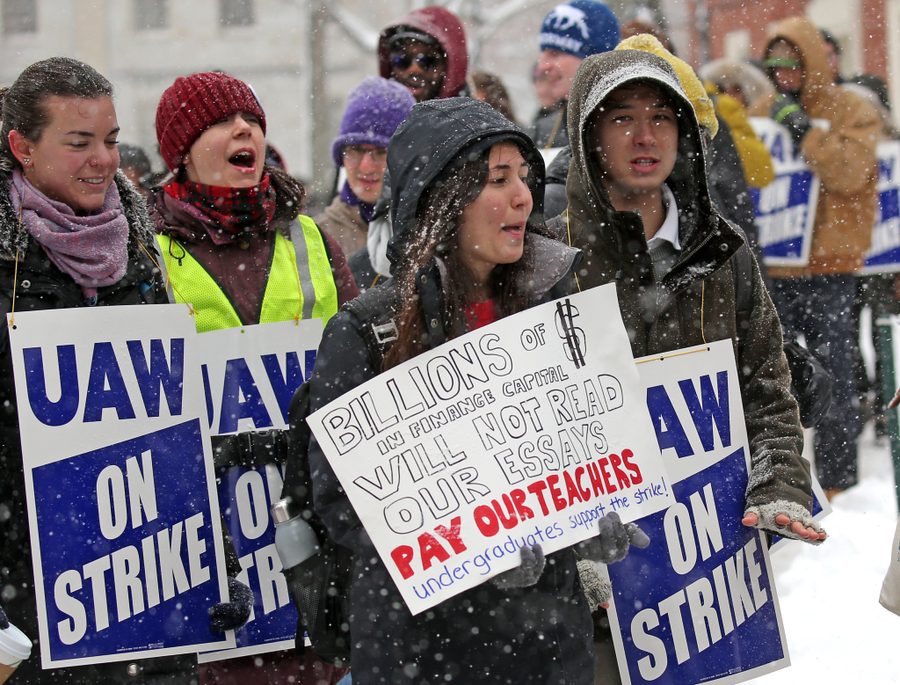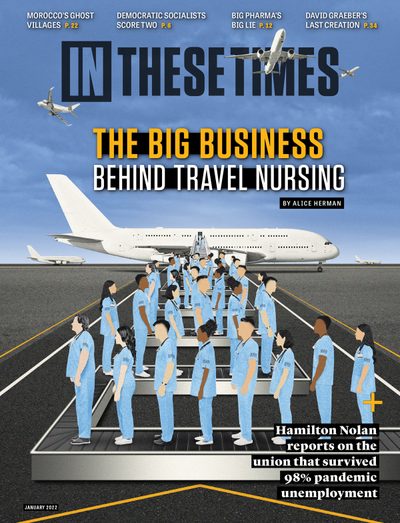Student Worker Isn’t an Oxymoron
This month University of California’s Student Researchers United-UAW won their union, the largest unit of student employees organized at once in U.S. history. Let’s look back 30 years at what campus organizers fought for.
In These Times Editors

What makes someone a worker? It’s a question unions and bosses have fought over for decades, and the debate is especially contentious around student workers. Research and teaching assistants assert that what they do is labor — despite university administrators, trustees and their union-busting law firms arguing the assistants are “primarily students” — with the National Labor Relations Board flipping its definitions many times over the past 50 years. Regardless, as Paul Selvin anticipated in 1989, student unions at campuses around the country continue to fight for recognition and fair working conditions, from Harvard to Northwestern to Kenyon.
On Sept. 13, 1989, Paul Selvin wrote: In the novel One Hundred Years of Solitude, Gabriel García Márquez tells the story of a U.S. banana company operating in Latin America. To avoid giving rights to its workers, the company claims that workers don’t exist. Company lawyers prove that “the banana company did not have, never had had, and never would have any workers in its service because they were all hired on a temporary and occasional basis.” These “non-workers,” naturally, were not legally entitled to unionize or sue for compensation after becoming sick from handling toxic chemicals.
Such scenarios are not just the stuff of fiction. On the Berkeley campus of the University of California (UC), and in many institutions of higher learning across the country, such nonsense, slightly modified, is purveyed. Graduate student employees — teaching assistants (TAs) and research assistants (RAs) — are not employees, according to the university administration, because they are temporary, “unnecessary” and primarily students, a claim recently supported by a California labor board and, ironically, based on a 1979 law intended to extend labor rights to university workers.
The student employees at Berkeley, not surprisingly, aren’t interested in this logic. At the end of last semester, graduate students walked out on their university jobs in a two-day show of strength. Organized by the campus union, the Association of Graduate Student Employees (AGSE), the walkout shut down the university.
“I regard teaching assistants more like serfs,” commented Professor Michael Burawoy, who joined the picket line. “Basically, the students are just asking to be hauled out of the Dark Ages.” As in any labor movement, the initial struggle is for union recognition, the right to collective bargaining. Bread-and-butter issues such as wages, healthcare and working conditions (such as the size of classes taught by TAs) are items to be brought to the table once the UC administration is forced to sit at it.
In fact, as the strike was intended to show, it is dubious that the university could handle its teaching load without TAs, who teach 58 percent of the lower division classes (or its research load without RAs, who were also found to be non-employees).
Partial victory: At Berkeley, collective action has paid off. Just a few days before the start of the new semester, fearing another strike, the university agreed to negotiate with the graduate student union over terms of employment. The university still claims that graduate student workers are not employees and vows to continue the legal battle, which is entering the California Court of Appeals. But until the case is settled— probably many years from now — collective bargaining will be a reality on the Berkeley campus. “It’s a victory,” says strike organizer Mary Ann Massenburg. “Once you have majority strength and are willing to show that strength, you don’t need to wait for the law .”








